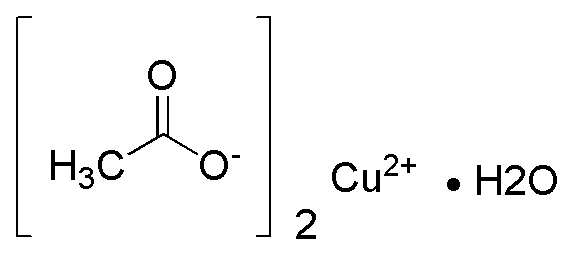Copper(II) acetate monohydrate is widely utilized in research focused on:
- Organic Synthesis: It serves as a catalyst in various organic reactions, enhancing reaction rates and yields, particularly in the synthesis of complex molecules.
- Material Science: This compound is used in the production of copper-based materials, such as conductive inks and coatings, which are essential in electronics manufacturing.
- Biochemistry: It plays a role in biochemical assays and studies, particularly in enzyme activity research, due to its ability to interact with proteins and other biomolecules.
- Textile Industry: Copper(II) acetate monohydrate is employed as a mordant in dyeing processes, helping to fix dyes to fabrics and improve colorfastness.
- Environmental Applications: It is used in the treatment of wastewater, where it helps in the removal of pollutants and heavy metals, contributing to cleaner water systems.
General Information
Properties
Safety and Regulations
Applications
Copper(II) acetate monohydrate is widely utilized in research focused on:
- Organic Synthesis: It serves as a catalyst in various organic reactions, enhancing reaction rates and yields, particularly in the synthesis of complex molecules.
- Material Science: This compound is used in the production of copper-based materials, such as conductive inks and coatings, which are essential in electronics manufacturing.
- Biochemistry: It plays a role in biochemical assays and studies, particularly in enzyme activity research, due to its ability to interact with proteins and other biomolecules.
- Textile Industry: Copper(II) acetate monohydrate is employed as a mordant in dyeing processes, helping to fix dyes to fabrics and improve colorfastness.
- Environmental Applications: It is used in the treatment of wastewater, where it helps in the removal of pollutants and heavy metals, contributing to cleaner water systems.
Documents
Safety Data Sheets (SDS)
The SDS provides comprehensive safety information on handling, storage, and disposal of the product.
Product Specification (PS)
The PS provides a comprehensive breakdown of the product’s properties, including chemical composition, physical state, purity, and storage requirements. It also details acceptable quality ranges and the product's intended applications.
Certificates of Analysis (COA)
Search for Certificates of Analysis (COA) by entering the products Lot Number. Lot and Batch Numbers can be found on a product’s label following the words ‘Lot’ or ‘Batch’.
*Catalog Number
*Lot Number
Certificates Of Origin (COO)
This COO confirms the country where the product was manufactured, and also details the materials and components used in it and whether it is derived from natural, synthetic, or other specific sources. This certificate may be required for customs, trade, and regulatory compliance.
*Catalog Number
*Lot Number
Safety Data Sheets (SDS)
The SDS provides comprehensive safety information on handling, storage, and disposal of the product.
DownloadProduct Specification (PS)
The PS provides a comprehensive breakdown of the product’s properties, including chemical composition, physical state, purity, and storage requirements. It also details acceptable quality ranges and the product's intended applications.
DownloadCertificates of Analysis (COA)
Search for Certificates of Analysis (COA) by entering the products Lot Number. Lot and Batch Numbers can be found on a product’s label following the words ‘Lot’ or ‘Batch’.
*Catalog Number
*Lot Number
Certificates Of Origin (COO)
This COO confirms the country where the product was manufactured, and also details the materials and components used in it and whether it is derived from natural, synthetic, or other specific sources. This certificate may be required for customs, trade, and regulatory compliance.


